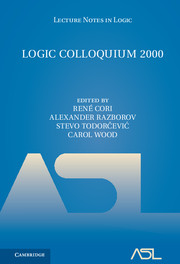Model theory and geometry
from TUTORIALS
Published online by Cambridge University Press: 27 June 2017
Summary
This paper is based on a series of three lectures that I gave during the LC 2000, in the context of the “tutorials” which have now become a tradition at the European meetings of the ASL. I have kept fairly close to the actual format and style of the talks.
It is always difficult to identify precisely the audience such a tutorial should address. A fair number of broad and ambitious surveys have already been published on the subject of the applications of model theory to algebraic geometry (see section 4.4). I did not, during this tutorial, choose to address the specialists of the subject. The audience I had in mind consisted of both young “inexperienced” researchers in model theory and more “mature” logicians from other parts of logic. Rather than attempting one more broad survey, I tried to present some of the main concerns of “geometrical model theory” by looking at concrete examples and this is what I will try to do also in the present paper.
We will discuss three algebraic examples, algebraically closed fields, differentially closed fields and difference fields (fields with automorphisms). The geometric application we will take up as illustration is Hrushovski's approach to the Manin-Mumford conjecture. This is based on a fine study of the model theory of difference fields and is quite emblematic of the method. Perhaps the key technical notion is that of “localmodularity”(or “one-basedness”), which arises in a purely model theoretic setting. We will see that the Diophantine conjectures of the Manin-Mumford type can be rephrased in terms of this notion. Furthermore, as one thinks through the rephrasing process, one realizes the need for the introduction of auxiliary algebraic theories such as the theory of difference fields.
I would like to thank the anonymous referee, despite my temporary shock at the initial suggestion that the paper be totally rewritten and turned into a survey of a completely different type. Fortunately, he/she also provided a long list of detailed comments and less draconian suggestions, in case I did not choose to follow this first drastic piece of advice. I have found these comments very helpful and have followed most of these suggestions.
- Type
- Chapter
- Information
- Logic Colloquium 2000 , pp. 3 - 31Publisher: Cambridge University PressPrint publication year: 2005



